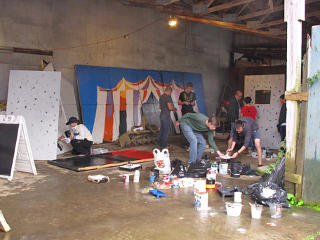
|
This was my seventh year helping with the Haunted Playground
effort. The
20th year
for the event itself, the fair bit of history behind it considerably
predates me so I still feel like a relative newcomer to the effort.
In case it isn't clear from prior-year
writeups, it's the major annual fundraiser for the Martins Pond Association,
the proceeds from which help maintain various aspects of the Pond and
the playground/park and general community.
[Said writeups, for reference: '08 '09 '10 '11 '12 '13 ] This year we were down a couple of key people as they'd moved out of the neighborhood, so various things they used to do got farmed out to others. What fell to me as additional responsibilities were things involving electricity in some way -- the PA / sound system, and the small collection of FRS radios used for event runtime management. As with prior years much of my view is about the technical infrastructure, but this time I've got a whole section specifically about it in more detail. I would love to find someone who's interested enough in these aspects that they'd want to help with it, as the various tasks I've shouldered over the years really are a bit much for one person. And there's always a possibility that I couldn't participate some year, or there's a bus out there with my name on it, or whatever -- basically, it couldn't hurt for me [and indeed, anyone on the crew] to have a backup. |
Day-of
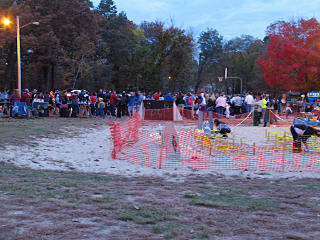
|
Quite a few attendees arrived around the start time, and it was clear that it was going to be a busy evening. |
Skits
| I did not manage to get any shots of the Graveyard at all this time, but it was more or less the same setup as previous years down there on the little sand beach. This time they borrowed a powered post-hole auger for construction, which made setting the fence posts a whole lot faster. But despite having nifty power tools to play with, the hard reality we were given to understand was that this would be the usual graveyard crew's last year for making it happen. It was always a ton of work for them, and a bit of burnout had set in -- they wanted a well-deserved retirement from the responsibility, and it was time for someone else to either take it over or come up with something different. |
|
I've talked about a lot of the support functions for this event before;
my prior-year reports dwell heavily on it and should also be consulted
for reference.
This year I was basically the one-man crew for power, lighting, sound,
video, and communication. It was doable, but my plate was *very*
full this year and as I said, I'd encourage anyone interested in
some of these technical areas to help out or even take on subsets
of the responsibility. To that end, I feel obligated to
document some of these areas a little better and outline the thinking
and process that went into them -- whether it came from me or from the
prior wisdom of the group. If you're *not* interested in
any of that, you'll probably find this entire section pretty boring.
But it's not magic, and in general anyone with a little technical acumen could easily put this stuff together. It just takes a little time to get all set up, and it helps to be comfortable on ladders. That's true of a lot of the event setup, in fact... we have all these 8-foot flats, and they all get fastened together by strutwork at the top. Anyway, this section is possibly a precursor for a manual on this stuff, useful documentation for, say, some year when I couldn't pitch in for some reason. It's fun to do the work; it's not quite as fun to be a single critical resource. And for the things I've come to be in charge of, I make absolutely no claim that I set them up in the most optimal way -- anyone would be encouraged to redesign parts to make them better! All of this is what the community makes of it. |
| It's a little more than "just plug stuff in", as there actually is an overall design of the setup. Here's an aerial of the park, overlaid with the basics of where we need to place lights and run power. It shows the model of bringing power out to the field from the pavilion, which is only one of several options for that area. |
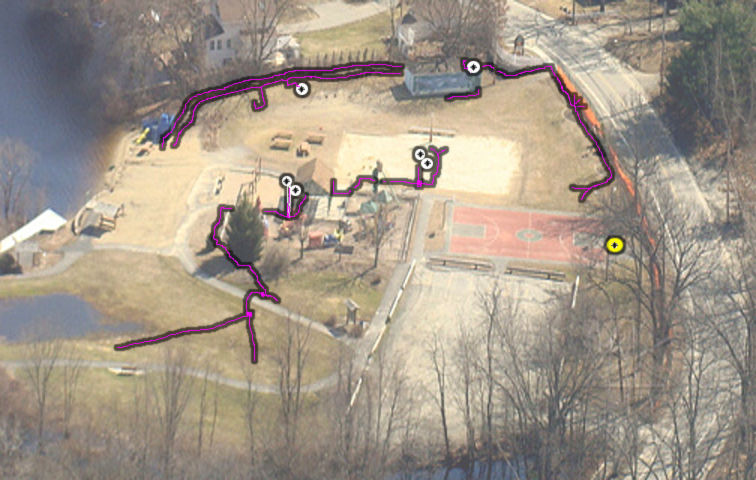
|
|
The single streetlight for the park is shown by the little yellow circle
near the road. The white circles are where I add our large lights
mounted up high, to flood much more of the area as evenly as possible --
especially over the "tot lot" playground itself and most of where people
will be milling around.
There's less need for broad-area light down at the beach and out toward
the field, where the skits provide their own effects-lighting as needed.
I usually use my own collection of heavy-duty extension cables to lay out the base feeds for all this, as MPA and other contributors don't own enough of same to fully provision what's needed. The Association also owns two giant ugly white Romex cables that are stored at the park, which hail from before my involvement; the two long shots to the beach are where those traditionally are used. With quite a few lights and sometimes things like foggers running too, the Graveyard had significant power needs and got most of two circuits available. [One was split to supply the minor needs of a light at the swings and the video truck.] If the Graveyard ceases to be or evolves into something else, the power map can be re-thought as needed. All existing site power ultimately originates from the breaker panel in the storage building. Some of the circuits appear at the pavilion. Refer to this map of available outlets around the whole facility, and note that I was already trying to make this information well-known back in 2011. We've basically got nine circuits to play with, a mix of 15 and 20 amp capacities. Power draw obviously should be balanced across different circuits and the expected loads taken into account. |
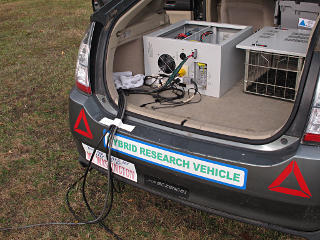
|
Here is a piece that is probably something other contributors can't provide in exactly this fashion, but there are workarounds that the event has used before. The skit tents in the field need modest amounts of power, and instead of stringing long cords from pavilion outlets it's easier to just bring in a local power source and plant it in the middle of the field between them all. This was done in the past with a generator, which created a huge amount of noise in the field -- to the noticeable detriment of the skits! The Prius "plug-out" unit is good for about 2400 watts total, balanced across two legs of 120/240V, and is far more quiet and efficient than a typical fixed-RPM gas generator. As another alternative, some of the newer inverter-style generator sets from Honda and the like are much quieter than their predecessors -- in fact they work much like the Prius rig, generating only as much DC as needed and inverting it back to 60Hz AC output. |
| This unit could not, however, supply the 13 or more amps on *one* leg to the Skilsaw that one of our construction crew was trying to use! On the overload it went into an error state and shut down, but at least it protected itself and didn't sustain any damage. In general, all the tent skits and pumpkin-patch combined shouldn't really be drawing any more than 2000 watts or so -- implying that the lighter-gauge but long extension cords can be used to distribute field power. It always helps to sanity-check anything electrical that a skit's team intends to bring in to make sure its demand is within reason. | |
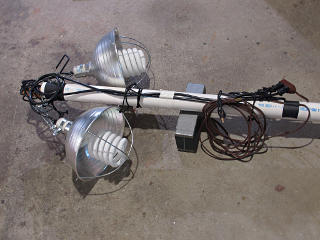
|
The PVC pipe we see the bottom of above is my same old light-pole, more or less designed and dedicated to the purpose with an appropriate hole that fits over the end of the threaded rod holding the volleyball net. There's actually a better shot of this thing from 2009, the first year I deployed it. This is generally put together in advance at home, it's just easier -- and then transported and set up as a single unit. The two "giant CFL" redneck-lights are clamped and tied to a piece of wood that inserts into the top of the pipe, and more ties and tape stabilize it against turning. As the ball-joints in the clamp light arms aren't very strong, the edges of the reflectors get fastened in near the pole to prevent wind from kicking everything around -- that's needed out there when it comes whipping off the pond during most days! |
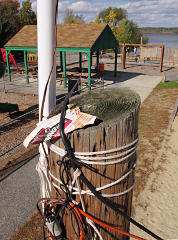
|
The pipe gets firmly lashed in near the top of the volleyball-net post,
and here we also see the power cord feeding all of this stretched overhead
running back to one of the pavilion outlets. Take note of a couple
of important details: the cable is padded over the bend, and anchored at
this end against the pull by a taut-line hitch of rope from below.
Now, what's interesting about this is that I missed a step that I'd done last year, which would have helped lessen the needed tension in the black cable. Take a look at this picture. It shows a midway support raising the cable fly nice and high, and I simply forgot I'd done that last time [as this was only the second year of flying this cable instead of trying to bring power to these lights some different way]. One of the two tall steel pipes we have has a little hook attached on the top specifically for this purpose and was right there stored in the park building; I simply forgot to bring it out and use it. |
| Another part of the rationale for doing this fly from the pavilion, midway-post or no, is that the same circuit can power these lights and also run to anywhere along the volleyball net to power the games tent and other stuff -- which would otherwise need to be fed from the storage building and winds up having a cable lying across a fairly high-traffic area. So running it this way is a notable safety improvement for our visitors. | |
| The five pavilion circuits also supply the food-prep equipment, such as crock pots, the popcorn maker, and the cotton candy maker. These need to be balanced across circuits to avoid overloading; I generally supply outlet-strips with longish feed cords to bring power down from the outlets up high and distribute it around to various points. The circuit numbers are labeled near the outlets, which I keep refreshing periodically with a sharpie -- P1 thru P5, from the breaker panel in the storage building. Most of the outlets are GFCI either at the outlet or the panel; P1 and P5 [at the west end of the pavilion] are *not* currently GFIed. If the skit-tents in the field are fed from the pavilion instead of an independent supply, P1 or P5 are the nearest outlets to there and whichever one is used should be largely dedicated to that purpose with little or no local loads. That implies careful rebalancing of the pavilion/food loads across the remaining circuits, and may limit usable capacity there. |
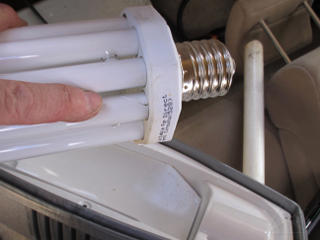
|
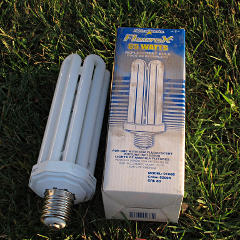
|
|
The klunky pair of outdoor fixtures on a crooked piece of wood and PVC pipe
that goes up over the tot-lot originally came from me but gets stored at the
park, where I suppose anything could happen to it. This year when I went
to test the assembly, the grey plastic 100-watt unit wasn't working.
There was a bit of condensation water inside the housing, so I was thinking
that might have gotten into the CFL circuitry or something.
Pulling the six screws and the front cover
for closer investigation revealed that the lamp itself had gotten a small
crack in the tube [where my finger is], rendering it nonfunctional.
Okay, so now I needed a replacement lamp, and after I was done with various
other setup tasks that afternoon I tooled off to Home Depot to try and
find one.
This is kind of an odd duck of a unit, with a mogul [read: big] screw base. Since HD used to sell the fixtures, they should have also carried the replacement lamps. But that was a few years ago, and grubbing through the outdoor-lighting section where this stuff used to reside wasn't turning up a whole lot. I finally dug *way* back behind the stock of metal-halide bulbs and 68-watt giant-CFL bulbs from EcoSmart [nee TCPi] that they're still selling, and my hand fell on the *last* lamp they had that would fit in the grey unit -- only 65 watts instead of the original 100, but that's all that was in stock and it would have to do. The dust on the box told the story of how old this lamp was, and I took it up to the customer-service desk to ask if there was *any* possibility they might have still had the 100W version in stock -- a long shot, but worth at least asking. Nope. They couldn't even look up a price on this 65W one since neither it nor any of the related "lights of america" product line was in their database at all anymore. Because of that, the guy at the counter couldn't actually sell the item -- so he gave it to me for free, and I simply walked out of the store with it. I guess I was helping them clear out old stock or something. Well, fine, but that also meant that a> running 65W instead of 100 meant it was less bright, and b> if this lamp stopped working, I was basically effed. But later I found out where to directly order the 100W lamps, as the company that supplies them is still in business even if they're not feeding Home Depot anymore. I ordered a real replacement from there a couple of weeks later. I imagine that down the road we'll have stuff all based on LED, but not until the prices get a little more reasonable. | |
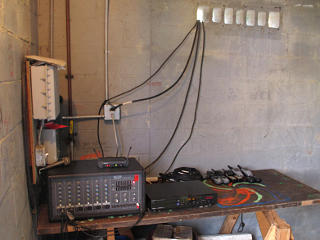
|
I put the sound system just inside the building as opposed to where it had been outdoors in previous years, for a little more protection under that day's minor threat of some rain. Power was right there to be had, and connections could easily run right outside above the table. [Said "table" is a door up on two sawhorses, as all the real folding tables we have generally get allocated to food service and games.] |
|
The sound system is fairly simple: a powered mixer, two speakers with 1/4"
output cables [in mono], and a wireless mic to send into it via XLR.
I also supplied an old CD player I had around as a music source, run
into the RCA "aux" inputs at line level. Various "mix CDs" of
Halloween-relevant music have been generated over the years, in various
levels of quality -- this should really be boiled down to a non-redundant
collection of MP3s or something, which could play in random order from
a laptop or ipod or the like. For this year I picked one of the
discs with the most tracks on it, set the player on "loop", and called
it a day.
The newer wireless mic from Shure is the one to use, as it's got far better quality and range than the old Audio-Technica 300. The user manual for the Shure is here; its major subtlety is that the microphone's working channel gets programmed from the base receiver via infrared link. Because our usual MC has a good strong "radio voice", I found that he was overdriving the front-end circuitry itself and to compensate, set the internal level switch to "-10dB" inside the microphone itself. An acceptable ballpark output level for the PA can be obtained with both the mic input and main output levels set around "noon", and adjusted as needed for live conditions. I found that as the park filled with people and got far louder, I had to sneak the levels of the MC and the background music up quite a bit to keep them sufficiently over the noise floor. This gear is currently stored in my basement, as that's what we came up with when the folks who moved away needed to unload it to somewhere else. Upon receiving it I went through everything to test it and eliminate parts and pieces we weren't using, so it's now a fairly clean package of amp, speakers, stands, cable, and mics all immediately road-ready. That should *not* mean I'm the only person qualified to set it up and use it, so anyone else interested in making this stuff work should pipe up! | |
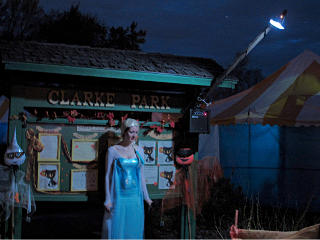
|
One final light went up on another outrigger, over where the tour guides welcomed each group before starting the walkthroughs. Again, putting the light in front of the subject allows approaching people to actually *see* it. For a couple of years now we've also put a small amplifier with a microphone here, to help the entire [and often noisy] groups hear the whole intro schpiel. In this case our guide was sporting one of several Elsa costumes that were running around that evening; there's a better shot of her here. I used another dim blue-colored "backstage" light here, whose relatively cold light worked really well with her costume! |
|
This is still by no means an exhaustive list of the lighting we use; each
skit gets a couple for basic switchable illumination and maybe some
special effects stuff. The dance-school tent has signs outside that
they want to light from the ground, and the Graveyard has always been
full of weird colors from weird angles to punch up the spookiness.
But where we aren't striving for a specific effect, broad and bright
for basic safety is what we're after. And as energy-efficient types
of lighting become more reliable and less expensive, we are gradually
"aging out" the collection of incandescent floodlights.
There are many more pictures from around the event on the MPA Flickr page, which as you might imagine dwell far less heavily on the inner workings of the event. And as one final infrastructure note, I also maintain the email list for coordinating most of the people and planning involved with this. Get involved, come join our crew! Get in touch if you'd like to be part of the fun. | |